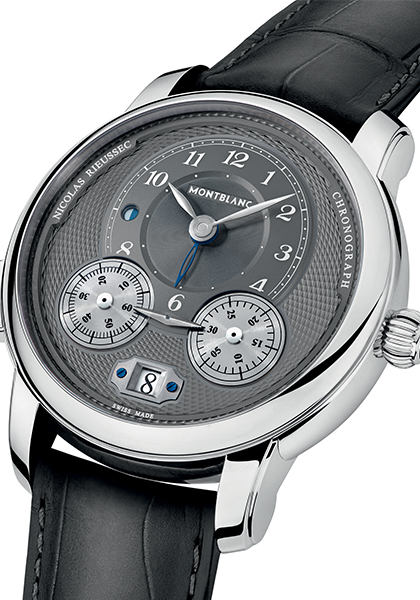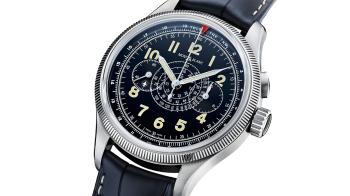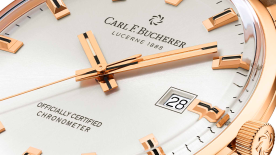Most watchmakers plan the way forward – developing new ranges, expanding their workshops, opening shops, etc. – through successive iterations, drawing from their history and heritage. It’s a steady, well-worn and well-understood path.
Montblanc’s approach is a million miles from this, and it’s not hard to work out why. Montblanc was originally a manufacturer of writing implements – the most prestigious in the world.
There’s a second reason: Montblanc is a German brand, founded in Hambourg in 1906. It doesn’t have any history in Switzerland. It has no connection to the repeal of the Edict of Nantes, which marked the rise of Swiss watchmaking and determined the central role played by Geneva, which grew to become the world capital of watchmaking, thanks to its trade, its public authorities, its locally-based workshops, not to mention the Geneva Seal, the Grand Prix, etc.
There’s one final reason: Montblanc’s manufacturing capabilities are relatively recent, dating to the acquisition of Minerva in 2007. In reality, many Swiss “manufactures”, even some of the most prestigious, only became so through buying into external concerns, but few of them are willing to admit it. Indeed, to be so transparent, it definitely helps if you’re not a horological native! Italian jeweller Bulgari has never hidden the fact that it entered the Haute Horlogerie world by buying Gérald Genta and Daniel Roth in 2000. Similarly, Montblanc has always been extremely open about its 2007 purchase of Minerva.

Once you understand these three distinctive traits (writing instruments, Berlin, recent arrival), you understand Montblanc, and why its product strategy is accelerating so quickly now. It has only recently been able to differentiate itself.
From snowflake to inkwell
25 years ago, Montblanc’s watchmaking was still secondary to writing instruments. Montblanc the watch brand was created in 1997. At the time, the goal was to sell watches that would complement the brand’s range of pens and leather goods. Montblanc Montres SA elected domicile in an opulent manor house in Le Locle built, like Montblanc itself, in 1906.
The name of the first collection came easily: Meisterstück. And the second was obvious in its own way: Star, after the star-shaped snowflake emblem. Male clients duly catered for, along came the Star Lady, followed by the long-lived Profile Lady. Once these foundations were shown to be solid, Montblanc moved on to sports watches, with the eminently sleek and modern TimeWalker. But none of these collections exist today.
Why not? It's hard to say for sure, but one (fortunate) event may have something to do with it. In 2008, Montblanc released the Rieussec chronograph. The movement was in-house, and the dial was stamped with its own remarkable and unique personality. The history behind the piece (the invention of the very first chrono-graph by Nicolas Rieussec in 1822 – a writing instrument of times gone by) was solid and convincing. The watch was extremely successful (and continues to be), but above all, it anchored Montblanc in a paradigm that appeared self-evident: contemporary, creative Haute Horlogerie, resting on historic foundations. The tone was set and Montblanc’s Haute Horlogerie signature was defined, in an era marked by the brilliant Alexander Schmeidt (who became head of Vacheron Constantin Americas 18 months ago).

Deliberate choices
But the launch of the Rieussec was not an isolated act: it was linked to the purchase by Richemont, Montblanc’s owner, of Minerva in autumn 2006. Hence the decisive impact of the years 2006 to 2008. The planets were aligned. Montblanc had an integrated manufacture, a historic heritage, and a first Haute Horlogerie timepiece, the Rieussec, which was an acknowledged watchmaking triumph.
It was no coincidence that the Montblanc Villeret 1858 collection appeared at the same time. The launch was inspired by the desire to strengthen the brand’s Haute Horlogerie trajectory with a confident follow-up. The collection is still in production today, backed up by a “Heritage” line whose name suggests a similar intention.
Today, the legitimacy of Montblanc’s strategy is beyond question. But its success came at the expense of some difficult choices, such as the decision to scrap the TimeWalker and halt development on disruptive pieces such as the ExoTourbillon, Mysterious Hours, and iconoclastic projects like the Metamorphosis. These were difficult choices, but vital to the clarity – and thus the legibility – of Montblanc’s Haute Horlogerie strategy. Some purists are even advocating for the retirement of the Summit collection of smartwatches. Everyone will have their own opinion on that.
Alpine prospects
What about tomorrow? The new head of watchmaking, Laurent Lecamp, is responsible for Montblanc’s future plans, and he intends to make a few changes. There are two possible directions in which he could take the brand. First, there’s the obvious and expected path of pulling on the Minerva thread to strengthen its showing in the vintage Haute Horlogerie segment. Then there’s the possibility of branching out into the tool watch segment. This is a highly competitive market, encompassing aviation, diving and motor racing-inspired timepieces. But Montblanc, thanks to its evocative name, has its own unique card to play: that of mountaineering.
The Iced Sea marks the first sally in this new direction. A limited series of 23 pieces will be unveiled at Watches & Wonders Geneva 2023, produced in partnership with The Fine Watch Club. It’s a unique opportunity and one we’ll be following very closely.





